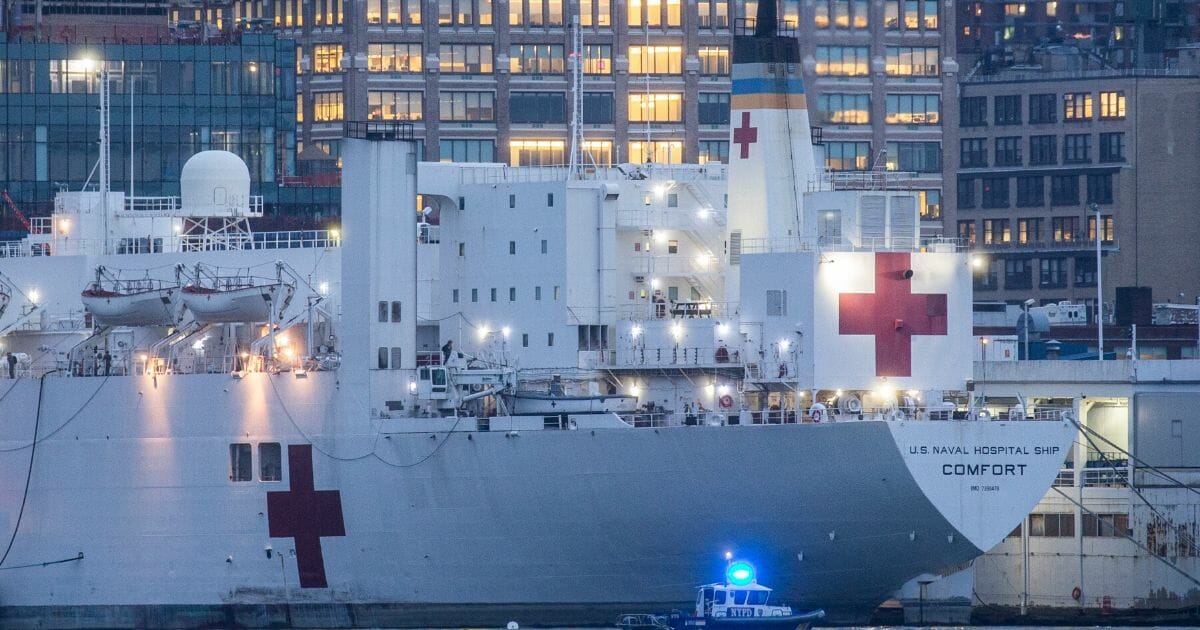
Expert COVID Prediction of 50K Hospitalizations in NY by April 1 Turned Out To Be 400% Too High
As coronavirus models go, the one put forth by the Institute for Health Metrics and Evaluation at the University of Washington, or IHME, has been one of the more optimistic ones.
According to The Washington Post, the model predicted 38,000 to 162,000 deaths in the United States — lower than most models and lower than the White House estimate of 100,000 to 240,000 deaths.
Even though it may be conservative, however, the IHME model might not have been conservative enough.
Take New York, the epicenter of the disease. According to the IHME model, the state would have needed 50,962 hospital beds on April 1, on the way to peak usage April 9. On that day, it would need 76,130 hospital beds.
Now, New York isn’t in particularly good shape when it comes to coronavirus, recording at least 1,867 deaths in New York City alone as of Saturday morning, according to Johns Hopkins University data.
However, the IHME model’s prediction of how many people would be hospitalized in the state by April 1 was much higher than what the actual number ended up being.

The model found that on April 1, New York would need 50,962 beds.
Former New York Times reporter Alex Berenson noted that projection was far off — it was 400 percent too high, in fact.
This is the @IMHE_UW model for #Covid_19, the new US standard. It was put out SIX days ago (post lockdown). It projects New York State will have 50,000 hospitalizations TODAY. Instead NYS has 12,000. Wrong by 4x in under a week. What on earth are we doing? https://t.co/zdRwaS4UJr pic.twitter.com/bRroolmKgw
— Alex Berenson (@AlexBerenson) April 1, 2020
The actual number as of April 1 was 12,226, according to WROC-TV. A total of 3,022 intensive care beds were needed, far short of the 10,050 predicted by the model.
While there could be an undercount given the nature of the disease and of testing, it’s unlikely that number has been undercounted by over 37,000 hospital beds total and over 7,000 ICU beds.
Keep in mind that this also isn’t like the much-cited Imperial College study out of the United Kingdom, which assumed a worst-case scenario where nothing was done and deaths topped 1 million people.
“The IHME model assumes every state will quickly impose stay-at-home orders, which some states, including Alabama and Missouri, have yet to do,” The Post reported. “It also assumes the entire country will maintain these restrictions until summer.”
This still doesn’t mean the situation is great, as New York Gov. Andrew Cuomo noted earlier this week.
“For me, facts are facts, and the facts that we offer the people of this state, and this country, they’re not pessimistic facts or optimistic facts — they are just the best information we have, as of this time, and I think that is empowering, and in some ways relaxing,” Cuomo said.
The models he’s looking at say the apex will come at the end of April and high death rates will persist in the state through July.
“They refine the model over time and the model changes and the numbers change, but what we’re looking at now is the apex, roughly at the end of April, which means another month of this,” he said.
Are the models right, though?
Dr. Anthony Fauci, a rare individual in Washington respected by people on both sides of the aisle, had this to say on the issue at a coronavirus task force meeting this week, according to The Post piece: “I’ve looked at all the models. I’ve spent a lot of time on the models. They don’t tell you anything. You can’t really rely upon models.”
The director of the National Institute of Allergy and Infectious Diseases said there were too many variables involved in the predictions.
This could be good or bad.
The Post article, for instance, is about how experts don’t trust the White House’s models; not that they didn’t think that deaths might not fall within that range, just that no one could express enough confidence to make those projections.
“We don’t have a sense of what’s going on in the here and now, and we don’t know what people will do in the future,” Jeffrey Shaman, a Columbia University epidemiologist whose work was cited by the White House, said.
“We don’t know if the virus is seasonal, as well.”
And that’s the thing — we don’t know.
Take this virus seriously. Wash your hands. Use masks, if you can find them.
What’s going on in New York City should sound a tocsin of alarm about what happens when coronavirus isn’t taken seriously enough.
However, taking models at face value is problematic.
Consider what Christopher Murray, the IHME head, said about the purpose of his work: “The reason we created our model is to help hospitals plan. How many beds you’ll need, how many ventilators, when the peak is likely coming.”
If they’re wrong about hospital beds — overestimating the number New York would need by over 400 percent — what does that say about the rest of the model?
Have we avoided the worst? Is the worst yet to come?
We don’t know — but what we can extrapolate is that, on some critical numbers, the IHME model is very wrong.
Truth and Accuracy
We are committed to truth and accuracy in all of our journalism. Read our editorial standards.
Advertise with The Western Journal and reach millions of highly engaged readers, while supporting our work. Advertise Today.












